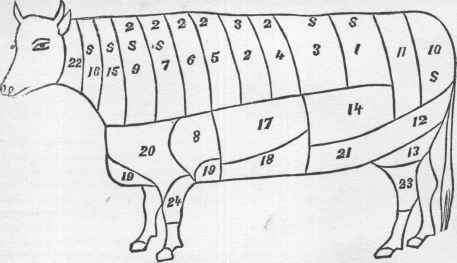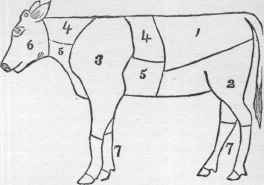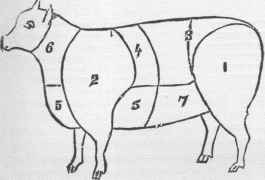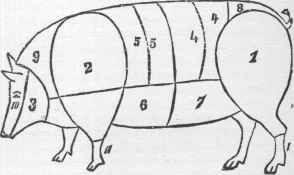MARKETING. 33
MARKETING.
In the " good old times, " as the fashion is to
describe preceding generations, it was much
more customary than now for the head of the
family, husband or wife, to “ go to market.” The
inevitable basket in which the purchases were to
be conveyed home, was carried generally by the
housekeeper, sometimes by an accompanying
servaat. " They tell " how a young dandy, mak
ing his morning purchase in Faneuil Hall market,
hired a plain-looking old man for a trifle to carry
home his marketing, and how the old man, after
performing his task and receiving the promised
pay, touched his hat and asked his employer
when thereafter he wanted such a service, to
“remember Billy Gray”—a name then standing
near the top of Boston's rich men. Now, in the
cities and large towns, and in their vicinity, the
butchers come or send for, and deliver orders;
the housewife thus being served, if the butcher
be capable and honest, more easily and cheaply
than in the old way. Many a goodman, as he
carves and distributes the savory joint, is unable
to tell, except in the most general way, from
what part of the “ creature” it came; nor can the
good-wife help him. Still there are many who
3
personally attend to their own marketing, as a
morning visit to any large market will show :
and their number might, with advantage to home-
tables, be greatly enlarged. Beef and veal, mut
ton and lamb, and pork, are the standard meats
expected in market.
BEEF.
In the New York markets a beef creature is
usually cut up according to the following dia
gram :
The pieces marked S are commonly used for
steaks : and the numbers on the top of the back

Choice Heifer for Beef.
Cut up and numbered as usual in New York City and vicinity.
1 S. Hip sirloin or thick sirloin.
2. Second-cut ribs or middle ribs.
3 S. Small end sirloin.
4. First-cut rib or first rib-piece.
5. Third-cut ribs or thick ribs.
6. First-cut chuck ribs.
7 S. Second-cut chuck rib.
8 S. Cross rib.
9 S. Third-cut chuck rib or chuck-piece.
10 S. Rump of beef.
11. Socket or face rump.
12. First-cut round.
13. Second-cut round.
14. Top of sirloin,
15 S. First-cut neck or neck-piece.
16 S. Second-cut neck or neck-piece.
17. Plate-piece.
18. Navel-piece.
19. Brisket-piece.
20. Shoulder clod.
2t. Flank-piece.
22. Third-cut neck or neck-piece.
23. Leg of beef or leg.
24. Shin of beef or shin.
show the number of ribs in each roasting piece.
In other parts of the country the butchers cut up
the beef in slightly varying ways, and use differ
ing names.
Good beef has a firm, fine grain, and a yellow
ish white fat. When first cut, it is of a quite
dark red color, but after a short exposure to the
air, turns to a clear cherry red. The beef should
have a juicy or sappy appearance, with a fine
smooth grain to the touch, and in cold weather,
or after having been thoroughly cooled by ice, it
should present a well-mixed or marbled appear-
Beef.................................................. 33
" Billy Gray “.................................... 33
Lamb....................................... 35
Mutton.................................... 34
Pork................................. 35
Veal................................. 34
34
THE FRIEND OF ALL.
ance. The fat should be of a clear straw-colored
look, and that on the outside should entirely
cover the back of the loin and ribs, in some
places not less than half an inch. The suet
should be of a brighter shade than the meat or
muscle fat, should be hard and dry, break easily,
and show little fiber. When oily or greasy, or
tough and showing tough fiber, you may know
that the animal has been overdriven, or impro
perly fed, and that the beef is not what you
want.
A great deal may be written, and unnumbered
directions given, as to the best cutting up of
meat, and as to what parts are the most appe
tizing and nutritious, but any person can learn
this so much more easily by seeing a creature cut
up, and taking notice what parts turn out best in
cooking, that we will not here attempt it. “Beef
steak” is said to have been discovered by a Ro
man of rank who had been set, as a punishment,
to act as a menial sacrificer to Jupiter ; and in
performing the task to which he was forced,
caught a piece that dropped from the coals. It
burned his fingers, which he then thrust into his
mouth. The slice thus carbonaded revealed to
him a secret that all the world now enjoys.
Here are the rules adopted one hundred and
fifty years ago, by the celebrated English “ Beef
steak Club.” They are as good today as they
were then :
“ Pound well your meat, until the fibers break;
Be sure that next you have, to broil the steak,
Good coal in plenty; nor a moment leave,
But turn it over this way, and then that.
The lean should be quite rare—not so the fat.
The platter now and then the juice receive.
Put on your butter—place it on your meat—
Salt, pepper; turn it over, serve and eat.”
De Voe, in his “ Market Assistant,” gives the
following as the origin of “porterhouse steak.”
A man named Morrison kept a porter-house
frequented by sailors, one of whom, a pilot, came
in hungry and called for a steak, just as Morrison
had cooked the last he had cut. He had no beef
except a sirloin roasting piece for his next day‘s
family dinner; and from this he cut off a steak for
the pilot, which so pleased him that he ordered
another, and demanded that thereafter all his
steaks should be like that. Others agreed with
him, and Morrison‘s butcher had to learn to cut
them that way “ for the porter-house;" whence
the name “porterhouse steak.”
VEAL.
The calf, slaughtered and dressed, is called
veal. In dressing, the skin is usually left on
until the day it is offered for sale, being retained
on the carcass for the purpose of keeping the
flesh bright, moist and clean. It is generally cut
up according to the following diagram;

1. Loin of veal.
2. Leg of veal.
3. Shoulder of veal,
4. Neck of veal.
The best veal is that of a calf not under four
or more than six weeks old, healthy and properly
fed. When wholly fed from the cow, the flesh is
what is called milk veal, white, tender, and deli
cate. After six weeks the calf requires more
food than it can get from its mother alone; and
this additional food increases the darkening
which would naturally take place. When turned
out and wholly fed on grass, the flesh becomes
poor, dry, tasteless and dark.
Good veal should be fine-grained, tender and
juicy, the fat firm and whitish. Not too white,
which may show that the calf was bled before
slaughtering, which, though it makes the veal
whiter, takes away juiciness and flavor.
The loin, breast and shoulder are used for
roasting pieces. Chops are cut from the loin and
from the neck. The neck is used for pies, frica-
sees, stews, etc. ; the leg for cutlets, fricandeaux,
stews and roasts. A fillet of veal is a solid piece
cut from the leg ; and the lower part, the knuckle,
is very satisfactory for soups and sauces.
The season for veal is April to September. It
is not a nutritious or easily digested meat, but it
is so available for different nice dishes, and its
price so low in the season, that it always sells.
MUTTON.
A sheep, to make the best mutton, should be
between three and five years old. The fat is then
better mixed through the flesh when full fed, and
if not driven too far the animal will have a large
kidney fat. The cosset-wether generally makes
the best mutton. The fat should be white, clear
and hard, the scored skin in the fore-quarters
nearly red, the lean firm, succulent and juicy,
darkish red, and the leg bones clear, and almost
or quite white.
The hind-quarter of mutton is made up of the
leg and the loin, and taken from a prime animal
will weigh twenty to thirty pounds. For a large
family or a boarding-house, the whole hind-
auarter makes a fine roast: but for a small family
5. Breast of veal.
6. Calf's head.
7. Calf s feet.
MARK
ETING. 35
either the leg alone, or the loin alone, is better.
The leg has comparatively little bone, and al
though the price is greater, it is the most econo
mical piece to buy. The two loins joined to
gether are called a saddle.
Mutton is usually cut up as in the following
diagram:

1. Leg of mutton.
2. Shoulder of mutton.
3. Loin of mutton.
4 and 6. Neck of mutton.
5. Breast of mutton.
6. Scrag (end of the neck).
7. Flank of mutton.
The fore-quarter includes the shoulder and
breast, and with the shoulder-blade taken out
makes a good roast for a large family. The
shoulder alone is good for roasting or broiling,
and the breast alone can be used for a roast, for
broths, or for stewing. Rib chops are cut from
the breast.
Chops and cutlets are cut from the loin. They
are called long if the flank is cut on them, and
short if it is not.
LAMB.
Lamb is cut and sold like mutton, but will not
keep as long, for, being juicy, it taints more
readily. When nearly a year old, it loses its
tenderness and begins to taste like mutton. It
Is in season from May to September.
To choose lamb, examine the fat on the back
and that of the kidneys, both of which should be
white, hard and of the same color. Beware of
two or three colors of fat found about the dress
ing of the hindquarters, as very likely the differ
ence comes from the mixing of two animals.
Watch against a blown or spongy appearance,
indicating human breath, which you certainly do
not want to buy—at any rate, in that shape.
PORK.
In spite of the peremptory prohibition of
pork among the ancient Hebrews, which has
come down unchanged to their descendants, the
present Jews—or Israelites, as they prefer to be
called—and the occasional discouraging words
which are flung at it by a doctor, Pork holds its
own. It makes an enormous part of the meat
consumed today over a large part of the civilized
world. That word covers the flesh of all ages
and both sexes, natural, altered or spayed, after
the creature ceases to be a “ roasting pig.”
For immediate use the best pork is from an
animal whose carcass will weigh from fifty to a
hundred and twenty pounds. The skin should
be nearly white and semi-transparent in color;
the fat on the back should be at least half an inch
thick, firm and white, and the lean of a pale red
dish color. Larger hogs, those used for bacon,
hams, etc., have a thicker and coarser skin than
the younger and lighter, and their meat, though
equally sweet, tender and juicy, is of a darker
color. Such animals run from one hundred and
fifty to five hundred pounds, though sometimes
their weight reaches ten to twelve hundred
pounds. The quality of their flesh depends much
upon their feeding, Indian-corn, it is generally
agreed, giving the most desirable pork.
The animal is thus cut up:

1. Leg or fresh ham.
2. Shoulder (after being trim
med).
3, Chops or cheeks.
4, 4. Loin pieces,
5, 5. Rib, or chine pieces.
6. Brisket.
7. Flank.
8. Tailpiece.
9. Neck-piece.
10 Plate, or skuli.
11. Feet.
There are variations here and there from this
method (especially with hogs cut up for export),
but we need not consider them here.
The legs and shoulders are usually salted and
smoked. The loin of a large animal has two or
three inches of the fat cut with the rind. This
is salted, and the loin roasted fresh. In a small
animal the loin is scored and roasted. The ribs
are treated like the loin, and when the rind and
fat are taken off, are called spare-ribs, and can be
roasted. The ribs and loin are used for steaks
and chops. The brisket is corned, as is also the
flank. The head and feet are often sold fresh.
Generally, however, the head is halved and
quartered and corned, and the feet are usually
pickled. The inside fat and the scraps are
cooked slowly until dissolved, then strained and
cooled, and the product is called lard.
But first, if you want to come back to this web site again, just add it to your bookmarks or favorites now! Then you'll find it easy!
Also, please consider sharing our helpful website with your online friends.
BELOW ARE OUR OTHER HEALTH WEB SITES: |
Copyright © 2000-present Donald Urquhart. All Rights Reserved. All universal rights reserved. Designated trademarks and brands are the property of their respective owners. Use of this Web site constitutes acceptance of our legal disclaimer. | Contact Us | Privacy Policy | About Us |